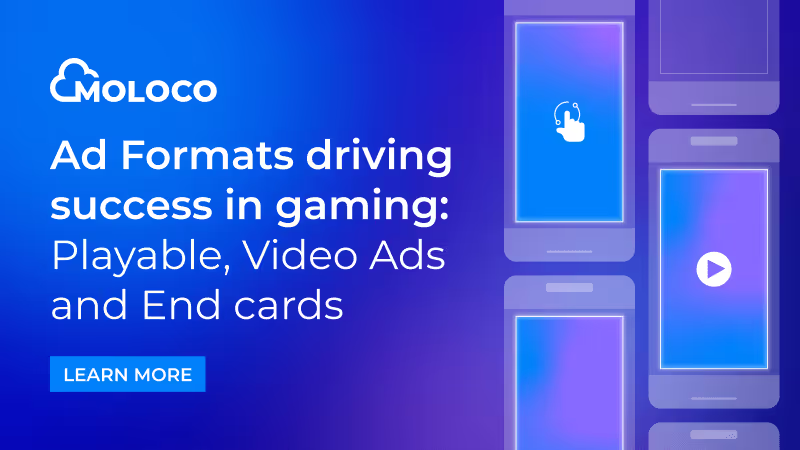Blog Article
Amongst app publishers, surely there’s a common joke like: “put three app publishers in a room, ask them if they prefer waterfall or in-app bidding, and you’re bound to get seven different answers.” There are various approaches, but with the market for in-app advertising forecasted to grow by 9% year over year through 2027, it’s important that publishers understand the benefits of the different revenue streams.
In recent years, in-app bidding has gained significant traction among publishers. Based on our discussions with publishers, bidding now constitutes around 80% of the typical publisher’s setup, and this figure is expected to grow as more ad networks transition to bidding-only models. As the shift continues, it’s becoming essential for publishers to tap more ad networks to stay competitive.
To help app developers maximize the value of their ad inventories, Moloco launched the Moloco in-app bidding SDK. By offering publishers direct access to Moloco’s global demands, the Moloco SDK is designed to optimize performance for advertisers, maximize revenue for publishers and create a better ecosystem for all parties involved. Already, publishers like comico are seeing the benefits.
"By integrating with Moloco SDK, we significantly enhanced competition and increased our returns. The results of our A/B tests demonstrated notable improvements in both eCPM and ARPDAU, leading us to quickly transition all our traffic to Moloco SDK"
[Check out the full success story]
But how exactly do these benefits come to life, and how does in-app bidding compare to the traditional waterfall approach? What should publishers keep in mind when evaluating these two methodologies?
To gain a clearer understanding, we spoke with Yoni Markovizky, Moloco's Global Head of Supply. With a decade of experience in in-app monetization, Yoni has deep expertise in how real-time bidding unlocks the full potential of mobile advertising.
Discussed Questions
What are the primary differences between in-app bidding and waterfalls?
With the waterfall approach, publishers set the value of each impression per ad network, giving them control over pricing. However, this process demands a lot of manual work. Publishers need to optimize fill rates and latency at each price point, set up region-specific configurations, adjust for user data availability, and adapt to seasonal and environmental factors like optimizing for LAT and IDFA users.
In contrast, in-app bidding allows all buyers to bid at the same time, with each optimizing their spending based on performance, rather than depending on the fixed rates used in the waterfall model. However, managing these real-time bids can be difficult. To address this challenge, many performance-focused buyers access platforms like Moloco, which utilizes machine learning (ML) to automate targeting and bidding, making the process more efficient.
Are there any disparities in performance?
Operating a waterfall involves multiple placements to call ad networks, going through hundreds of line items one by one to try to place an ad. In contrast, in-app bidding removes this sequential process, resulting in a more streamlined and significantly faster auction. In almost all cases we've observed, SDK waterfall publishers who transitioned to SDK bidding were able to increase ARPDAU and this was true even without raising media costs or impressions, primarily due to reduced latency and enhanced efficiency. Also, by saving time and resources on manual optimization, developers can focus their efforts on other growth areas, such as product enhancement, user acquisition efforts, and better user experience.
What are the reasons some publishers prefer to stick with waterfalls instead of adopting in-app bidding?
Over the last few years, the choice between in-app bidding and waterfall has been a topic of debate in the ad tech industry. In my experience, the right answer is “it depends”.
Some publishers continue to favor the waterfall approach because it allows them to control pricing and prioritize networks according to their business goals. For example, brand advertisers often aim for top-of-funnel KPIs like awareness, resulting in budget allocations that differ significantly from those of performance-based advertisers and the metrics used by networks like Moloco. In cases like this, manual pricing can be an effective way to capture these demands. However, it's crucial to note that poorly configured waterfall setups can limit the effectiveness of budget spending on inventories. This inefficiency may cause performance-based advertisers and ad networks to restrict or even stop bidding on these inventories, which can have a significant negative impact on publishers' ARPDAU.
Based on my observations, advertisers are increasingly prioritizing performance-driven campaigns—and at Moloco, I’ve seen this growing preference for in-app bidding and increased competition amongst advertisers significantly boost revenue for publishers. Moreover, buying traffic through in-app bidding provides partners like Moloco with valuable signals, such as more accurate win/loss notification signals which greatly enhance the optimization of our ML models to predict better auction prices and eventually improve advertisers' performance. I can’t speak for every exchange or DSPs, but this has proven to be especially true for Moloco’s partners, who tend to use our platform because our ML models help them automate their work to yield better returns on their ad spend.
Can you elaborate further? How does in-app bidding improve optimization for ML model predictions?
As mentioned earlier, in-app bidding not only provides additional signals that enhance ML model training but also greatly simplifies the bidding process compared to the waterfall approach. In the waterfall approach, multiple duplicate bid requests are often sent for a single impression, creating unnecessary noise. In contrast, in-app bidding allows publishers to send a single, consolidated request for each impression, eliminating that inefficiency.
This streamlined method enables us to allocate more computing power to advancing our ML models. With fewer duplicate requests, we can focus on processing genuine bids, enhancing overall efficiency.
The additional computing power allows us to implement more sophisticated algorithms that assess various factors influencing the value of each impression. These models analyze historical data and contextual signals in real-time, leading to more accurate predictions.
As a result, the bidding process becomes more dynamic, with bids optimized based on current data as well as anticipated future trends. This capability allows us to make smarter bidding decisions that maximize returns for advertisers while driving higher revenue for publishers. Overall, this efficient use of resources significantly enhances the effectiveness of our bidding platform.
Why is Moloco seeing better results for publishers using in-app bidding?
As I mentioned, Moloco built its ad platform with ML models that help advertisers optimize their return on ad spend.
What this means in practice is our ML models are trained on the performance data across the millions of bids and purchases that occur on our platform. These learnings inform the predictions for audience targeting and pricing per impression, and help buyers net better results and improve ROAS—which encourages them to increase their overall spend.
This creates a recurring cycle—better performance, enhanced learnings, smarter models, and increasing ad spend—that also benefits publishers, who see higher quality ads that match their users’ interests and more revenue across the overall ecosystem of ad spending.
If you’re interested in learning more about Moloco SDK, reach out to us today.
 Moloco SDK Turns One: Tracking a Year of Acceleration and Impact
Moloco SDK Turns One: Tracking a Year of Acceleration and ImpactCelebrating one year of the Moloco SDK—now fully self-serve, Google certified, and powering monetization for 500+ apps. See how it’s driving performance, transparency, and growth at scale.

.avif) Inside In-App Ads: Past, Present, and What’s Next?
Inside In-App Ads: Past, Present, and What’s Next?Moloco’s Shobeir Shobeiri joins the Two & a Half Gamers podcast to explore the evolution of in-app advertising and its growing impact on mobile game publishers

 Ad Formats driving success in gaming: Playable, Video Ads and End cards
Ad Formats driving success in gaming: Playable, Video Ads and End cardsDiscover which ad formats perform best, the latest creative trends, refresh strategies, and how Moloco helps gaming studios drive success through smarter creative execution

 The Truth about the Moloco SDK
The Truth about the Moloco SDKThe Moloco SDK isn't like any other mobile monetization SDK. Learn the truths behind what makes the Moloco SDK different from the rest.

